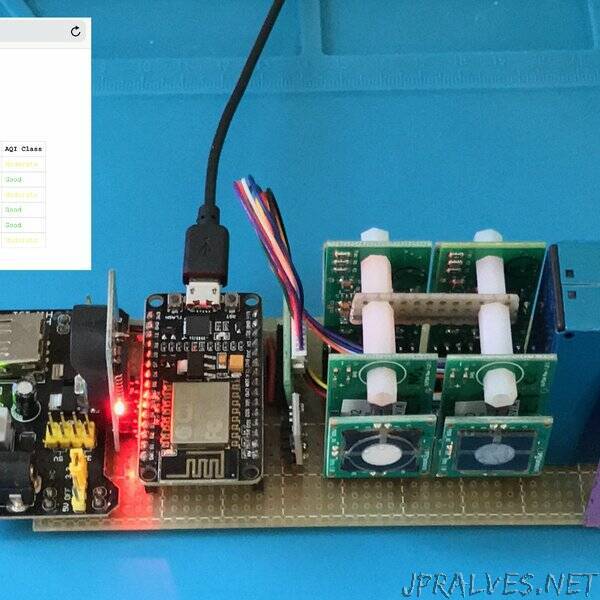
“Samples all 6 metrics the EPA uses to calculate Air Quality Index: 2.5 & 10um particulates, O3, CO, NO2, and SO2, and calculates AQI.
This prototype air monitoring system measures all six pollutants the EPA factors into its composite Air Quality Index (AQI). Most air monitor projects only measure particulate matter because fully-integrated particulate counters are cheap and easy to work with, with full onboard processing and a serial interface, and do not need to be recalibrated in the field. Ozone, carbon monoxide, and nitrous oxide are equally concerning, but until recently were not measurable without expensive lab equipment. This project uses factory-calibrated gas concentration sensors designed for medical equipment by Spec-Sensors. The gas sensors are sampled by a pair of 16-bit ADCs and heavily filtered on the ESP8266. A BME280 module provides temperature, humidity, and pressure, while a Plantower PMS5003 laser particle counter reports particulates. The ESP8266 serves a webpage showing latest values and hosts a REST server for offboard data logging.
This project was inspired by a general interest in pollution in the Los Angeles area and wanting to know how air quality varies by geography. I live in a neighborhood ten miles north of downtown LA and about 1500’ higher elevation, and often wonder if I’m living in LA’s smog layer. I figured there must be an air quality monitoring station nearby that might provide data for my neighborhood, but was somewhat disturbed to find that the EPA has only a single air quality monitoring station in the Los Angeles basin and another in the San Fernando Valley. That’s far too sparse to provide neighborhood-scale comparisons. I’ll spare you my speculation about why the EPA doesn’t do a better job.
A friend at work told me about NASA’s Air Quality Citizen Science program which is establishing a network of volunteers around Los Angeles and two other pilot program regions to provide much higher spatial resolution data which can serve as ground truth data for remote monitoring satellites. I now host a sensor for this network, but was surprised to find that the sensor module only senses particulate matter which count for only 2 of 6 pollutants the EPA factors into its composite Air Quality Index (AQI) indicator. I couldn’t find any projects which measure gas concentrations with sufficient accuracy and stability to resolve the various grades within the AQI scale for each gas (some of which measure in parts-per-billion), short of full-blown lab equipment and incredibly expensive field deployable units.
The Spec-Sensors gas sensors turned out to be just the thing I was looking for. I consulted with Spec-Sensors to ensure I could achieve the accuracy levels needed. The neat thing about these sensors are that they are precisely calibrated at the factory and hold their calibrations indefinitely. It is still necessary, however, to precisely calibrate the host system. Specifically, the analog driver boards from Spec-Sensors float uV-scale signals on top of a carrier voltage which is approximately half the supply voltage. The driver board provides a readback pin with this carrier voltage, but sampling that pin with anything short of a lab-quality ADC with exceptionally high impedance distorts the measurement. Instead, for this project, I sampled the supply voltage and output signal from each gas sensor board for two months, then compared to data from a nearby EPA station and solved for bias voltages for each gas sensor by minimizing sum-squared error between the sampled voltages and the EPA data. I subsequently logged 2 more months of raw voltages and calibrated values and found the calibrated values to show good correlation with the nearby EPA station.
Now what do I do with this? The system is portable. I originally envisioned logging data while driving around Los Angeles, then driving up the Angeles Crest Highway into the Angeles Forest to see how the smog varies with geography. However, the signals are so faint that it’s necessary to average over about 30 minutes (one hour to match EPA criteria). That would be a very long day. A network of co-calibrated modules would work much better. The prototype cost approximately $250 (the same price as a PurpleAir AS-II module which only samples particulates, by the way), cheap compared to other systems of comparable capability but not cheap enough for me to fund my own curiosity project. Maybe a gofundme or kickstarter project? I wouldn’t know where to start.”
